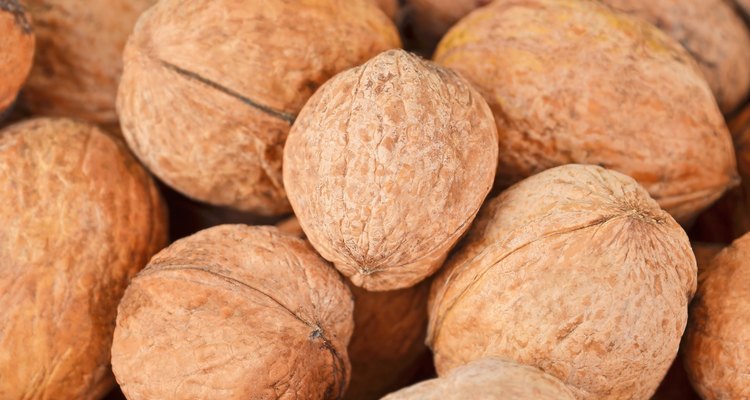
unkas_photo/iStock/Getty Images
Hickory nuts (Carya) are the fruits of several different types of trees that belong to the walnut and pecan plant family. The hard-shelled nuts of the hickory tree are enclosed in soft green or greenish-brown husks that eventually split and are easy to remove once the fruit has fallen off the tree and dries. While all hickory nuts are edible, not all have an appealing flavor; those that do can be used interchangeably with pecans and walnuts in cooking and baking.
The Tasty Hickory Nuts
While hickory nut trees can be grown domestically, it takes years for them to start producing, and the chances of harvesting them are greater in the wild. The shagbark hickory (Carya ovata) is found across the eastern half of the United States and is easily identifiable by its shaggy bark that peels away in large strips on mature trees. The husks resemble small green pumpkins and grow in clusters that drop off in early fall. Other tasty varieties include the pecan (Carya illinoinensis), the shellbark or kingbark (Carya laciniosa), the sand hickory (Carya palida), the mockernut (Carya tomentosa) and the red hickory (Carya ovalis). All produce sweet kernels that have a slightly wilder flavor than the standard pecan.
The Not-So-Tasty Hickory Nuts
While the taste of other types of hickory nuts isn't appealing to humans, they provide an important food source for wildlife and birds. Although they resemble their edible counterparts in the shape of their husks and shells, one taste is enough to tell you that they're best left to the deer, squirrels and crows. These bitter-tasting species include the bitternut hickory (Caryna cordiformis), the pignut hickory (Carya glabra) and the water hickory (Carya aquatic)
Shelling the Nuts
After undergoing a drying and curing period, the nutmeats of hickories can be laborious to separate from the shells, and their small size generally makes them impossible to get out in one piece. The shells are slick and smooth, making them a challenge to hang onto with typical nutcrackers. Positioning them on a solid surface, such as a flat rock or brick, and cracking them open with a hammer can be messy, but it's less likely to demolish the entire nut than the traditional nutcracker will. Have a nut pick ready, as well as a bowl for the nutmeats, and plan to refrigerate or freeze them if you won't use them right away.
Using the Nuts
Any of the palatable hickory nuts can be used as you would any other type of nut in cooking and baking. Because the nutmeats themselves are so small, you'll need more of them to fill a measuring cup, and you most likely won't have to chop them at all. Add them to your next batch of chocolate chip or shortbread cookies or your favorite banana-nut bread recipe, using the same amount as you would of other types of nuts. Alternatively, use the sweet nuts in an old-fashioned version of pecan pie called molasses-hickory pie. Hickory nuts also add crunch to a green salad as well as cooked dishes, such as wild rice sauteed in butter and seasoned with fresh green onions and lemon thyme.
Related Articles
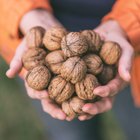
How to Prepare Raw Walnuts

What Is a Hickory Nut?

Are Buckeyes & Chestnuts the Same?
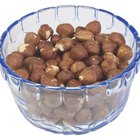
What Kinds of Nuts Don't Grow on Trees?

How to Eat Hickory Nuts
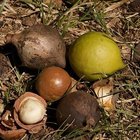
How to Toast Macadamia Nuts
How to Crack Pecans Without Breaking ...
How to Salt and Dry Pistachios

How to Eat a Raw Chestnut

How to Roast Maple and Brown Sugar ...

Type of Peanuts Used to Make Peanut ...

How to Soften Garbanzo Beans

How to Freeze Ramps & Wild Leeks

How to Make Your Own Shoe Tree

How to Blanch Cashews

How to Remove a Cardamom Seed From a Pod
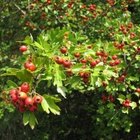
How to Pick Hawthorne Berries
How to Blanch Walnuts

Fruits or Vegetables Starting With X
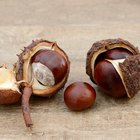
How to Preserve Buckeye Nuts
References
- Mother Earth News: A Fall Field Guide: Foraging for Nuts
- Mother Earth News: Hickory Nuts: The "Inside" Story
- Pinenut.com: Hickory Nut Information and Recipes
- University of Nebraska Lincoln Extension: Nuts: Harvesting and Storing
- Cornell University Cooperative Extension: How, When and Why of Forest Farming
- Missouri Department of Conservation: Missouri's Hickories
- Serious Eats: Wild Hickory Nut Shortbread Cookies
Writer Bio
Rachel Lovejoy has been writing professionally since 1990 and currently writes a weekly column entitled "From the Urban Wilderness" for the Journal Tribune in Biddeford, Maine, as well as short novellas for Amazon Kindle. Lovejoy graduated from the University of Southern Maine in 1996 with a Bachelor of Arts in English.
Photo Credits
unkas_photo/iStock/Getty Images